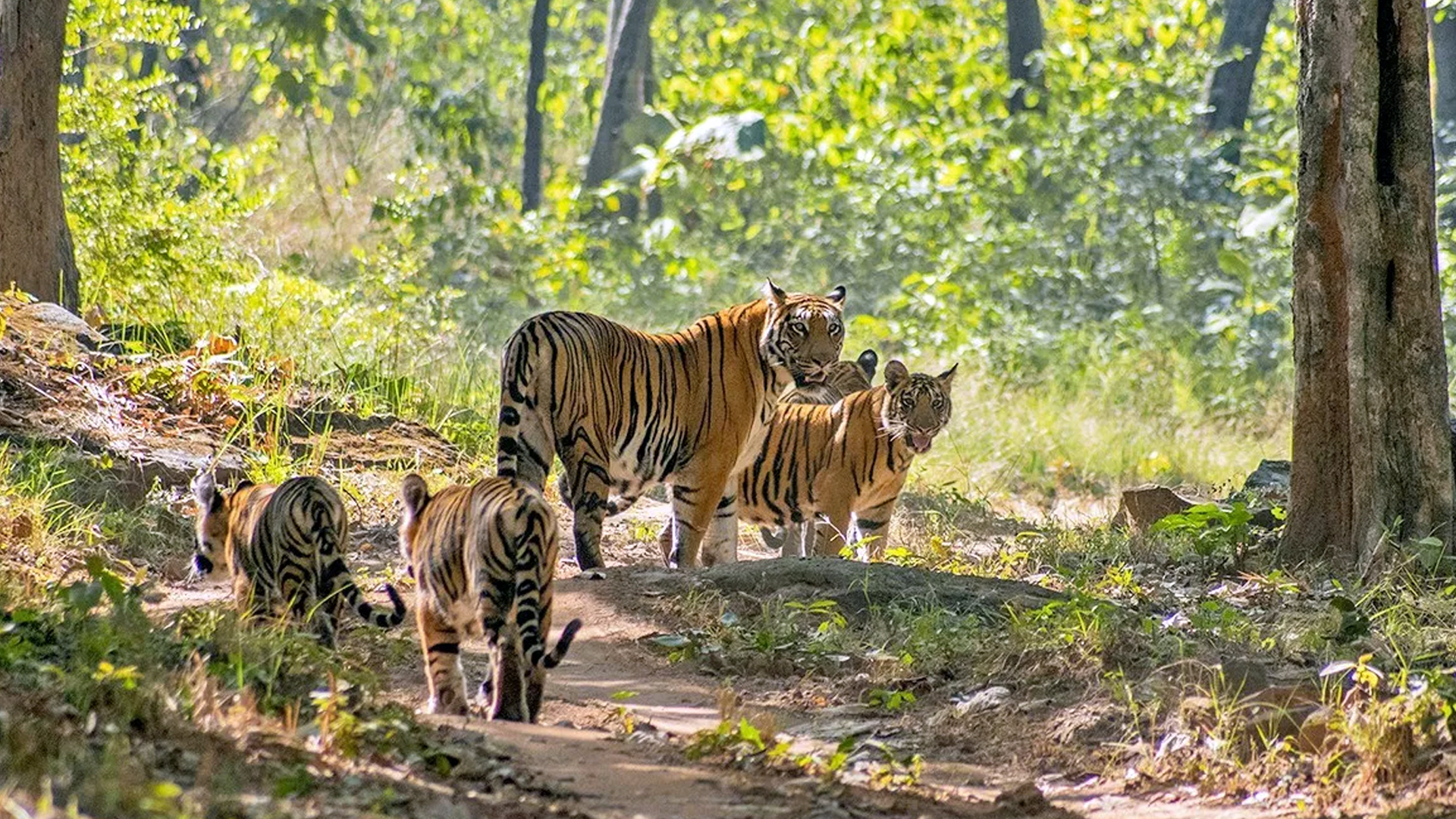Satpura
.jpg)
Satpuras are the highest mountain ranges in Central India. Covered by dense forest cover, they are home to more wildlife species than any other forest in the country. This includes the tiger, the giant Indian bison, sambhar, spotted deer, blackbucks, sloth bear, wild boars, wild dogs, gazelles, chinkara, barking deer, giant squirrels, flying squirrels, crocodiles, several species of dangerous snakes, scorpions, and many many species of butterflies and birds. The Satpura Tiger Reserve which occupies a major portion of these forests and mountains is surrounded on two sides by the beautiful and vast backwaters of the Tawa dam. Its major rivers Tawa, Denwa, Malini, Bori, Sonbhadra and Nagdwari are flooded with these backwaters and are home to thousands of rare migratory birds from far off corners of the world.
Reputed to be older than the Himalayas, it is for this reason that humans have inhabited them since times immemorial. Satpuras are not just a forest, but hold centuries of mysteries yet undiscovered, folklore and stories yet untold.
Madhai

In the verdant forest you look up, and the green canopy of the tall Sal trees meets your eyes with tiny blue patches of the sky showing through the openings. As your eyes wander downwards, on the ground, grasses and shrubs harbour, half-hidden from your view, chital, gaur and sambar. Even if you do not see a tiger, probably a tiger has been you as you drive through the forest.
The emerald green meadows, valleys densely wooded with thick stands of Sal & Teak, hill slopes covered with mixed forests of Saja, Bija, Tendu and Bamboo, and the plateau with grasslands scattered with stunted tree growth are the homes of the spectacular wildlife of MADHAI.
Streams criss-cross the terrain and the river Denwa meanders along the MADHAI forests. As a jewel on the heart of the Central Indian highlands, Satpura Tiger Reserve lies nestled in the Mahadeo range of the Satpura Mountains.
Satpura National Park (Madhai) is located in the Satpura hill ranges and surrounding area; mainly in the Hoshangabad District of Madhya Pradesh (near Pachmarhi). The area forms part of the largest remaining contiguous forest in India. It is, in itself, a unique area of highly natural and diverse land resources. This area is also outstanding in its bio- diversity and for many years has been a paradise for botanical scientists. The nature of the terrain, which is both rugged and largely difficult to access, has afforded the area a significant degree of natural protection.
The variety of altitude, slop and rainfall give rise to rich and luxuriant vegetation, which is among the most noteworthy in India. Both the principal timber trees of India, the North Indian Sal and the South Indian Teak are found in the area. Also present are Bamboo and mixed miscellaneous forest and a rich variety of ferns including tree ferns, bryophytes and other plant groups. The amazing diversity of plants includes around 1300 flowering and non-flowering plants are found here. Trees like Palas whose flowers streak the forest with vermilion in March. And Jamun whose fruits are relished by birds and animals alike, to ground-hugging grasses and the picturesque Bamboo that few know is really a grass.
It contains a large number of rare and endemic plants, especially bryophytes and pterdiophytes like Psilotum, Cythea, Osmunda, Lycopodium & Lygodium etc. that must be protected from extinction. On higher plateaus of Satpura Tiger Reserve (National Park) Sal forests exist on Gondwana Sandstone, whereas on lower plains, Teak forests grow on basaltic traps. It is interesting to note that some species, which are not common elsewhere in Madhya Pradesh, are found in this area. These are Malastoma Malabthricum, Maraya Paniculata, Holmkildia Senguines, Blumea Lancelaria, Sophora Interrupta etc.
Though famous all over the world for the awe-inspiring Indian Bison or Gour, Madia is home to 30 species of mammals, almost 200 species of birds, over 26 species of reptiles and innumerable species of insects.
Madai Sanctuary harbours a great variety of wild animals including the endangered Tiger, Leopard or Panther, Wild Dog, Wolf, Sloth Bear, Indian Bison, Samber, Chital or spotted deer, Chinkara, Chousingha or Fur horned Antelope, Barking deer, Nilgai, Ratel, Pangolin, Smooth Indian Otter and Marsh Crocodile. This area has historically been renowned for Tiger, Gaur and Sambhar; the latter two supposedly in the finest sizes found in the country. At least 14 endangered species of mammals, birds and reptiles inhabit these forests. The Flying Squirrel, Indian Giant Squirrel and Mouse deer must be regarded among the most sensitive to habitat changes. Also noteworthy is the presence of both Red and Grey Jungle Fowl, which are usually, found separately either in north or South India respectively. This protected area is also a paradise for people interested in avian fauna; more than 210 species of birds can be seen, which include Malabar pied Hornbill, Malabar Whistling Thrush and the State bird Paradise Flycatcher. The area especially that around Pachmarhi to Madhai is extremely rich in butterflies and over 50 species are recorded. These include the Orange Oak Leaf, which resembles a dry leaf perfectly when sitting with its wings folded. One gets to see its brilliant orange and blue colors only when it flies or opens its wings to bask in the sun.
Meticulous efforts go into keeping madhai in its pristine form. Ever vigilant staff is posted at strategically located forest camps. They patrol the forests day in and day out, in the scorching heat of summer, in the chilling cold of winter and in the lashing of the mansoon to ensure the safety of the wildlife and of its habitats against fires, poachers and intruders.
To these and other efforts is credited the fact that madhai is one of the best protected wildlife areas not only in India but also in the whole world. This area is archaeologically and anthropologically very important, there being more than 100 rock shelters with beautiful paintings dating from 3000 to 10,000 years old, which facilitate studies of human evolutionary history. A great deal can be learnt from these paintings, which are among the finest examples of rock paintings in India. They depict battles, ceremonies, processions, hunts, group dancing, honey collection, fishing and numerous other daily activities.
A long history of conservation

Madhai & Bori prides itself on being one of the oldest wildlife sanctuaries in India. Declared as a reserve forest in 1857, it was notified as a wildlife sanctuary in 1975 and as a national park in 1982. The Satpura Tiger Reserve is declared by Govt. of India, dated 10 Feb. 2000 expanding over an area of 1427.87 sq.km. under Project Tiger.
How to reach
By Rail: The nearest railway stations near Madhai are - Sohagpur (20 km.), Piparia (40 km) and Hoshangabad (60 km.).
By Road: Bhopal to Madhai (130 km.), Indore to Madhai (310 km.), Jabalpur to Madhai (210 km.), Sagar to Madhai (215 km.) , Pachmarhi to Madhai (90 km.) and Nagpur to Madhai (310 km).
Best Season: 01st October to 15th June.
The Park is closed from 16th June to 30th September.
.png)